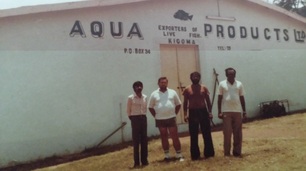 Directors - Jayant Vaitha, Asgar Remtulla and Kirit Vaitha with a German customer, Mr. A. Greshak of Afrika Aquarium - 1983
Directors - Jayant Vaitha, Asgar Remtulla and Kirit Vaitha with a German customer, Mr. A. Greshak of Afrika Aquarium - 1983
Aqua Products Limited Brief History
Introduction
We think that it is important to share with you our immense contributions and experience on the Lake Tanganyika tropical fish information and business, using this platform. The information may help you to fill in the many blanks and enlighten you on some of the missing facts. We have been in the tropical fish business since 1980, and over the years we gathered so much information, discovered and rediscovered so many fishes and their locations. We have shared this information with many people, authors, documentary film makers, etc. in good faith and thinking that the information shared would be fairly documented, but we found that most people decided to take all the credit to themselves and never bothered to portray the real source of information, due to reasons only known to them. Our work was also been documented by several television channels including CNN, NHK, etc and various newspapers in the 1980’s . Below, you will find some of our valued contributions. We will try to write whatever we recall. On the same site, we have a blog page where you may ask us any questions you may want to ask and we will try to answer. Otherwise, please email us at [email protected] or [email protected]
We have also included pages for African Art and Craft – all made by Tanzanian artists and by hand. We will offer many more products with prices soonest. Custom made products are also possible, please contact us for details.
Introduction
We think that it is important to share with you our immense contributions and experience on the Lake Tanganyika tropical fish information and business, using this platform. The information may help you to fill in the many blanks and enlighten you on some of the missing facts. We have been in the tropical fish business since 1980, and over the years we gathered so much information, discovered and rediscovered so many fishes and their locations. We have shared this information with many people, authors, documentary film makers, etc. in good faith and thinking that the information shared would be fairly documented, but we found that most people decided to take all the credit to themselves and never bothered to portray the real source of information, due to reasons only known to them. Our work was also been documented by several television channels including CNN, NHK, etc and various newspapers in the 1980’s . Below, you will find some of our valued contributions. We will try to write whatever we recall. On the same site, we have a blog page where you may ask us any questions you may want to ask and we will try to answer. Otherwise, please email us at [email protected] or [email protected]
We have also included pages for African Art and Craft – all made by Tanzanian artists and by hand. We will offer many more products with prices soonest. Custom made products are also possible, please contact us for details.
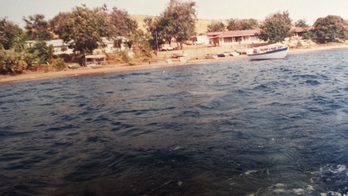 Our properties, Aqua Products Limited and Aqua Lodge as seen from the lake in 1991.
Our properties, Aqua Products Limited and Aqua Lodge as seen from the lake in 1991.
How we got started
In 1980, we got interested in starting fish processing business in Kigoma and so we acquired a big place in Bangwe area on the shores of the lake. We wanted to catch dagaa, a sardine like fish of genus Stolothrissa tanganicae and family Clupeidae. And so we started fishing and processing by salting, drying and packaging in small bags ready to sell. While doing this, we came across some very colourful fishes seen from our boat and by snorkelling. We caught some and put them in a small glass tank. We had heard about some people doing business of exporting these in the past and in a small way. We wanted some information on how to keep these fishes, if it had any market, and if yes, how to export them live. We tried to find people who may have known something about this, but found nothing. And so we bought a book explaining the basics of aquarium and fish keeping. Then we wrote to some Embassies to check if they may give us contacts of importers. And yes, we got few contacts who had business of importing Live Fish. Those were the days of writing letters, posting, and waiting weeks for a reply. One importer was interested and sent us a photo of Tropheus Red moorii, that’s what we called it, without a clue of where it was found. He wanted it in any quantity and this got us hooked into finding this fish.
In 1980, we got interested in starting fish processing business in Kigoma and so we acquired a big place in Bangwe area on the shores of the lake. We wanted to catch dagaa, a sardine like fish of genus Stolothrissa tanganicae and family Clupeidae. And so we started fishing and processing by salting, drying and packaging in small bags ready to sell. While doing this, we came across some very colourful fishes seen from our boat and by snorkelling. We caught some and put them in a small glass tank. We had heard about some people doing business of exporting these in the past and in a small way. We wanted some information on how to keep these fishes, if it had any market, and if yes, how to export them live. We tried to find people who may have known something about this, but found nothing. And so we bought a book explaining the basics of aquarium and fish keeping. Then we wrote to some Embassies to check if they may give us contacts of importers. And yes, we got few contacts who had business of importing Live Fish. Those were the days of writing letters, posting, and waiting weeks for a reply. One importer was interested and sent us a photo of Tropheus Red moorii, that’s what we called it, without a clue of where it was found. He wanted it in any quantity and this got us hooked into finding this fish.
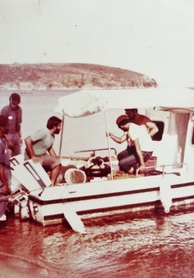 Start of yet another expedition on Lake Tanganyika searching for fishes in 1984. Director Jayant Vaitha with crew.
Start of yet another expedition on Lake Tanganyika searching for fishes in 1984. Director Jayant Vaitha with crew.
And the Start……
We had an aluminium boat (a life boat discarded from M.V. Liemba), modified to use an outboard engine, which we used for our expeditions, searching for the Tropical fishes. We only knew about dagaa , Sangara (Nile Perch) and Kuhe (Boulenerochromis microlepis) which we later came to know is the largest cichlid in the world! We used the normal nets for collecting fishes as monofilament nets were unknown and unavailable to us at that time, and kept on improvising it every day. We had bought masks and flippers from Dar es salaam of various sizes, some we already had. We bought many plastic buckets, big and small, for using in the boat for keeping fish and water. We had temporarily employed 5 staff and one of them was a boat driver. One of them was Kazumbe and the boat driver was Moshi – do these names ring any bells? We will come to that later. And so now we were equipped to start our search for tropical fish – the Tr. Red moorii.
We had an aluminium boat (a life boat discarded from M.V. Liemba), modified to use an outboard engine, which we used for our expeditions, searching for the Tropical fishes. We only knew about dagaa , Sangara (Nile Perch) and Kuhe (Boulenerochromis microlepis) which we later came to know is the largest cichlid in the world! We used the normal nets for collecting fishes as monofilament nets were unknown and unavailable to us at that time, and kept on improvising it every day. We had bought masks and flippers from Dar es salaam of various sizes, some we already had. We bought many plastic buckets, big and small, for using in the boat for keeping fish and water. We had temporarily employed 5 staff and one of them was a boat driver. One of them was Kazumbe and the boat driver was Moshi – do these names ring any bells? We will come to that later. And so now we were equipped to start our search for tropical fish – the Tr. Red moorii.
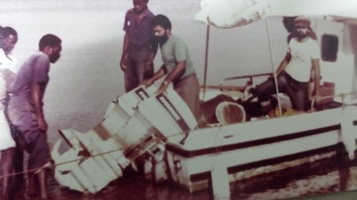 Ready for exhibition. Director Jayant Vaitha with a friend and crew in 1984.
Ready for exhibition. Director Jayant Vaitha with a friend and crew in 1984.
Later we were to find a small book which had some few photos
of Lake Tanganyika fish e.g. N.
brichardi, N. leleupi, H. horei, and N. elongatus. It only had crude photos and
no other information at all. Of course, books were available, but provided
scientific information only and nothing for a hobbyist. Even such books were
hard to find in Tanzania.
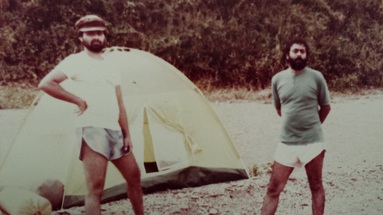 Jayant Vaitha with a friend camping on the shores of Lake Tanganyika, south of Malagarasi.
Jayant Vaitha with a friend camping on the shores of Lake Tanganyika, south of Malagarasi.
The Great Search For
Tropheus Red Moorii - Year 1981
Our first expedition was only around Kigoma area, including Bangwe bay, south and north parts of Kigoma. We found lots and lots of fishes (check The Fish List), but we could not even know if they were of Cichlid family or not, neither did we know anything about this fish family. We did not even know if these fishes are of any interest in the market, but they were nice, colourful and knew that they would look pretty in any aquarium. Our main aim was to find Tr. Red Moorii! We went on with our expeditions and covered many areas including Katabe, Katonga, Ujiji, Kaseke, Karago, and Malagarasi and took us months in doing this.
Our first expedition was only around Kigoma area, including Bangwe bay, south and north parts of Kigoma. We found lots and lots of fishes (check The Fish List), but we could not even know if they were of Cichlid family or not, neither did we know anything about this fish family. We did not even know if these fishes are of any interest in the market, but they were nice, colourful and knew that they would look pretty in any aquarium. Our main aim was to find Tr. Red Moorii! We went on with our expeditions and covered many areas including Katabe, Katonga, Ujiji, Kaseke, Karago, and Malagarasi and took us months in doing this.
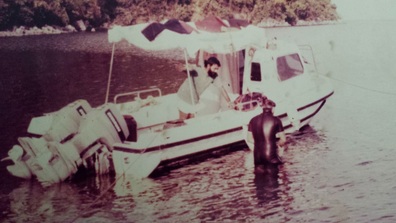 In action! Jayant with a friend. 1984
In action! Jayant with a friend. 1984
For identification of fish and locations, we drew rough
shape of fishes we found, recording colours and markings, and made a note of
area where it was found to help us track if necessary. We went on naming most
of these fishes by their location and so you find names like Tr. Kigoma, Tr.
Ujiji, Tr. Malagarasi, and so on and are still in use. Much later, after we started
exporting them, we were to find out that what we had collected were mostly cichlids
and got some technical information on them also. In a period of one year, we
had made several such expeditions and finally found Tr. Red moorii around
Mahale area – Rubugwe. And named it Tropheus Red Moorii. But while looking for
this fish, we found many beautiful fishes around the same location – check The
Fish List.
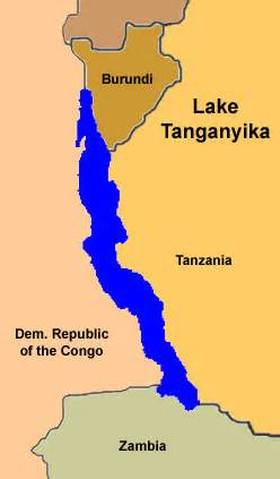
More Expeditions and the fun
of finding more new fishes………..Year 1982-3
We used our own boat for expeditions up to Ikola where we had found Tr. Yellow (Kaiser), and also found so many others – check The Fish List. And we started using M.V. Liemba for expeditions further south to Kipili, Namansi, Wampembe, Kala, Kasanga and Kalambo. We carried an inflatable boat for moving from place to place. We found many new and good fishes on our first trip to Kipili and its surrounding areas, including the islands and all the way to Kalambo where we found the most colourful tropheus and called it Tr. Red rainbow. Similar tropheus also found around Kasanga, but not so red and this is why we called it Red Rainbow. We had Tr. Green rainbow found Kala. Very beautiful Alt. Compressiceps with golden head was found around Kasanga together with more coloured N. brichardi which was later named Dafodil. Please check our The Fish List for all what had found and named.
All above listed and more fishes were found or re-discovered by us and most of them were named by us and we know that all who knew us during those years will agree. We also know many fishes were never known before and so we can safely say that we discovered them, but never got any credit neither any mention of this immense contribution and hard work in any book or articles. We went on telling our customers all these locations without hiding anything and they shared this with authors to make books, but without mentioning anything about us or the actual source! Some of them even brought authors to us and we provided all logistics including our crew for taking them around various places and fish locations. Unfortunately and sadly, we did never see any mention of this contribution or any credit in any books made so far.
We used our own boat for expeditions up to Ikola where we had found Tr. Yellow (Kaiser), and also found so many others – check The Fish List. And we started using M.V. Liemba for expeditions further south to Kipili, Namansi, Wampembe, Kala, Kasanga and Kalambo. We carried an inflatable boat for moving from place to place. We found many new and good fishes on our first trip to Kipili and its surrounding areas, including the islands and all the way to Kalambo where we found the most colourful tropheus and called it Tr. Red rainbow. Similar tropheus also found around Kasanga, but not so red and this is why we called it Red Rainbow. We had Tr. Green rainbow found Kala. Very beautiful Alt. Compressiceps with golden head was found around Kasanga together with more coloured N. brichardi which was later named Dafodil. Please check our The Fish List for all what had found and named.
All above listed and more fishes were found or re-discovered by us and most of them were named by us and we know that all who knew us during those years will agree. We also know many fishes were never known before and so we can safely say that we discovered them, but never got any credit neither any mention of this immense contribution and hard work in any book or articles. We went on telling our customers all these locations without hiding anything and they shared this with authors to make books, but without mentioning anything about us or the actual source! Some of them even brought authors to us and we provided all logistics including our crew for taking them around various places and fish locations. Unfortunately and sadly, we did never see any mention of this contribution or any credit in any books made so far.
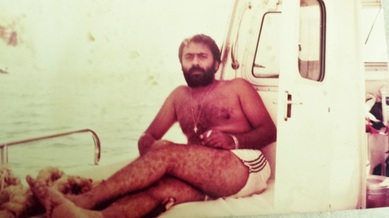 Jayant Vaitha relaxing with a cigarette during an expedition in 1984
Jayant Vaitha relaxing with a cigarette during an expedition in 1984
And The Start of The BIG
BUZZ and The Scramble for Fish and Information………….
We had made a small documentary film, the first of its kind, filmed entirely by one of our importer friend. We had provided all logistics including boats, information, crew, fuel, etc for the Tanzanian side of filming. The aim was to create more interest by showing the real habitat of these fishes in a movie form. Photography was already successfully done by this same importer friend and many books used this photos also. This, combined with our exporting new species brought a renewed interest in these fishes and also created a BIG BUZZ. Some of importers secretly came to the lake and started their own collection and exporting themselves, but only after stealing our staff who had experience and knowledge of what we were doing. Total unethical behaviour only for the lust of money!
We had made a small documentary film, the first of its kind, filmed entirely by one of our importer friend. We had provided all logistics including boats, information, crew, fuel, etc for the Tanzanian side of filming. The aim was to create more interest by showing the real habitat of these fishes in a movie form. Photography was already successfully done by this same importer friend and many books used this photos also. This, combined with our exporting new species brought a renewed interest in these fishes and also created a BIG BUZZ. Some of importers secretly came to the lake and started their own collection and exporting themselves, but only after stealing our staff who had experience and knowledge of what we were doing. Total unethical behaviour only for the lust of money!
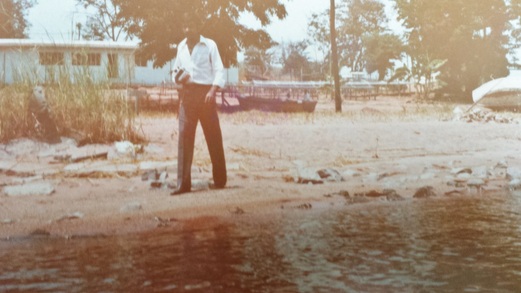 Kirit Vaitha taking a walk on the beach at our property. 1983
Kirit Vaitha taking a walk on the beach at our property. 1983
Unpaid export – Learning the
hard way And Caution To New Exporters
We would like to mention also that the first couple of export shipments in 1981 were never paid and our importer disappeared after receiving the shipments. He had sent his personal cheques which all bounced (unpaid) and we never got a single cent! Our bank manager had warned us not to accept such personal cheques, but it was too late to take his advice as shipments were already out and delivered. We never ever heard again from this importer, but were told later that he did sell the fishes in the market. But all this was learning for us, the hard way, and taught us the trade. It was a big loss to us, but we decided to go ahead by borrowing from friends. We also found a good book by Pierre Brichard which had some information and photos of fishes which helped us. And we also came to know that Brichard was collecting and exporting tropical fishes from Burundi. We also found out that there was a British man in Zambia doing the same there. And so now, in 1981, we were 3 collectors and exporters, one in each country.
And another bad experience in early 1990’s where bankers cheques returned unpaid! We took our case to a European court, but nothing happened and we lost a lot of money.
We would like to mention also that the first couple of export shipments in 1981 were never paid and our importer disappeared after receiving the shipments. He had sent his personal cheques which all bounced (unpaid) and we never got a single cent! Our bank manager had warned us not to accept such personal cheques, but it was too late to take his advice as shipments were already out and delivered. We never ever heard again from this importer, but were told later that he did sell the fishes in the market. But all this was learning for us, the hard way, and taught us the trade. It was a big loss to us, but we decided to go ahead by borrowing from friends. We also found a good book by Pierre Brichard which had some information and photos of fishes which helped us. And we also came to know that Brichard was collecting and exporting tropical fishes from Burundi. We also found out that there was a British man in Zambia doing the same there. And so now, in 1981, we were 3 collectors and exporters, one in each country.
And another bad experience in early 1990’s where bankers cheques returned unpaid! We took our case to a European court, but nothing happened and we lost a lot of money.
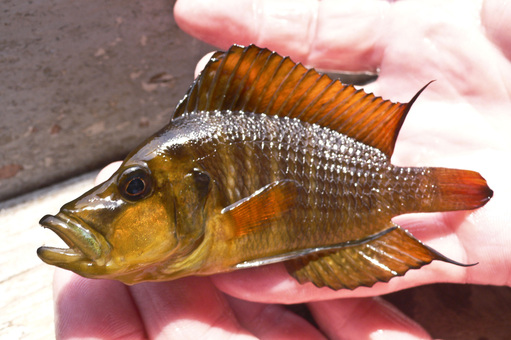 Altolamprologus Compressiceps red - favourite in the market!
Altolamprologus Compressiceps red - favourite in the market!
DISCOVERING ALT. COMPRESSICEPS
RED, PET. KAZUMBE, PET. MACROGNATHUS, PET. ORTHOGNATHUS, PET. RED AND PET. MOSHI – THE
STORY
Grub, son of the famous Jane Goodall, found it. He may have been around 10 years old at that time in 1983, but expert in snorkelling and fishing. He had seen this one day while snorkelling around Gombe, got fascinated and caught one and brought it to us in Kigoma still very much live and in good health. Few days later, we went for collection and made successful exports. Alt. comp. red is still our favourite.
Grub, son of the famous Jane Goodall, found it. He may have been around 10 years old at that time in 1983, but expert in snorkelling and fishing. He had seen this one day while snorkelling around Gombe, got fascinated and caught one and brought it to us in Kigoma still very much live and in good health. Few days later, we went for collection and made successful exports. Alt. comp. red is still our favourite.
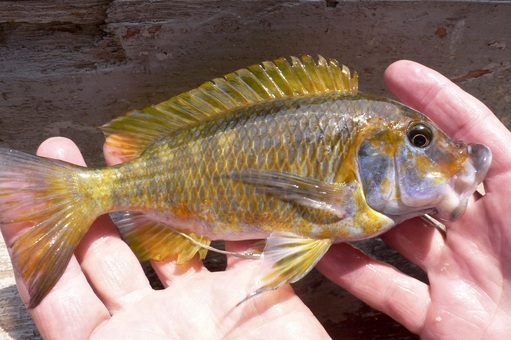 Petrochromis kazumbe
Petrochromis kazumbe
We found Pet. kazumbe at bangwe bay for the first time in 1983 and named it Pet. mawese. Mawese is the red/orange palm oil found in abundance around Kigoma and because this new Petrochromis had similar colour patches on the body we named it mawese. Later, this fish was a big hit in the market and we decided to change the name to kazumbe - name of our top diver Kazumbe Sudi, as he was the one who had brought the first specimen out of the lake.
The yellow coloured Pet. moshi was also first collected by us in 1983 around Katonga area, south of Kigoma. Moshi Mussa, our boat driver who also learnt diving from us was the first person to lift this pretty colourful fish out of the lake! This fish was also a big success and we decided to honour him and named this fish Pet. moshi. Later, we found another variant around Karilani area which was more yellowish and prettier than the Kigoma one.
Pet. macrognathus. The scientist who had discovered this fish in north Congo region of the lake saw the same fish with us in Kigoma during his visit, collected around Kabogo area. We called it Pet. green kabogo – green for the colour and kabogo being the location.
When we foumd Pet. Orthognathus, we used to call it Pet. wakilongo – name of our diver who first caught it and brought it out. This trade name was used for several years.
PETROCHROMIS RED - Found at Rubugwe location. This was FIRST found by our friends Mark Deeble and Victoris stone, famous wild life film makers, in 1990. They were filming on fishes around Rubugwe - "A Little Fish In Deep Waters" and found this beautiful Pet. red. We also had provided logistics and other assistance to them and were adequately credited for this.They informed us about it and we went to collect the first specimen and successfully exported it in 1991.
The yellow coloured Pet. moshi was also first collected by us in 1983 around Katonga area, south of Kigoma. Moshi Mussa, our boat driver who also learnt diving from us was the first person to lift this pretty colourful fish out of the lake! This fish was also a big success and we decided to honour him and named this fish Pet. moshi. Later, we found another variant around Karilani area which was more yellowish and prettier than the Kigoma one.
Pet. macrognathus. The scientist who had discovered this fish in north Congo region of the lake saw the same fish with us in Kigoma during his visit, collected around Kabogo area. We called it Pet. green kabogo – green for the colour and kabogo being the location.
When we foumd Pet. Orthognathus, we used to call it Pet. wakilongo – name of our diver who first caught it and brought it out. This trade name was used for several years.
PETROCHROMIS RED - Found at Rubugwe location. This was FIRST found by our friends Mark Deeble and Victoris stone, famous wild life film makers, in 1990. They were filming on fishes around Rubugwe - "A Little Fish In Deep Waters" and found this beautiful Pet. red. We also had provided logistics and other assistance to them and were adequately credited for this.They informed us about it and we went to collect the first specimen and successfully exported it in 1991.